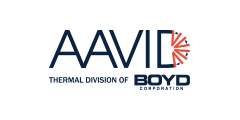THERMAL PERFORMANCE MODELING AND MEASUREMENTS OFLOCALIZED WATER COOLED COLD PLATE
As the electronics industry continues to face the increasing trend of heat dissipation in electronic components, water cooling is fast becoming an attractive design option for high performance thermal management. In designing a water-cooled cold plate the followings are some of the important design parameters:
o thermal pefiormance
0 water flow rate
0 pressure dropmechanical strength
0 corrosion & fouling
0 manufacturability
0 cost
Water flow rate and pressure drop influence the size of pumping and plumbing requirements, and ultimately the cost and the physical volume of coolant distribution system. Therefore in designing coldplates, it is of great importance to minimize the water flow rates and the pressure drop, yet ensuring sufficient thermal pefionnance.
In dense electronic packaging applications, there may be a few high heatdissipating components which require a cold plate with a very high level of cooling performance. Certain components with odd physical shapes, such as transformers, may present the cold plate designer with the challenge ofproviding water passages to restricted areas. Figure 1 shows the cooling requirements for a cold plate used with a high-heat dissipating power SUpp&. Each of the six shaded areas (shown as four areas, A,B, C & D) in the figure must COOI a heat dissipation rate of 5 to 15 watts per square centimeter. Also shown in the figure are areas (designated as ‘open area’) where water passage is not allowed due to other packaging requirements. The combination of requirements for highly localized performance and restrictedflow passage adds additional challenge to the cold plate design for this application.
In this paper, two rather unique cold plate design concepts are presented to address therequirements outlined in Figure 1. They are:
o drilled hole design
o press-fit tube design
The cross sections for the designs are shown in Figure 2. These two concepts are suitable to accommodate requirements for localized high-cooling performance, and allow water passages to be laidout around the geometric restrictions.
Developments of the cold plates using these concepts to meet the requirements shown in Figure1 are presented in this paper. Prototype cold plates have been built, and measurements were made forthermal petiormance and pressure drop. Models were developed to predict the thermal performance and the pressure drop. Comparisons between the predicted and the measured values over a range of waterflow rate are presented.
|
|
|
|
Application note & Design Guide |
|
|
|
|
Please see the document for details |
|
|
|
|
|
|
|
|
|
|
|
English Chinese Chinese and English Japanese |
|
|
2018/01/17 |
|
|
|
|
|
|
|
|
617 KB |
- +1 Like
- Add to Favorites
Recommend
- Flow Types in Aavid Genie: Ducted Versus Bypass Flow
- Sekorm Became an Official Authorized Distributor of Aavid
- Boyd Acquires Sensata’s Thermal Test and Controls Business
- Aavid‘s Liquid Cooling Systems: Modular or fully customized liquid cooling optimized for improved heat dissipation in condensed volumes
- AAVID Provides A Thermal Solution Optimizing Internal and External Thermal Radiation and Internal Conduction
- Boyd‘s New Art Facility in Mexico Features Automated Manufacturing and Assembly Processes
- Boyd Corporation Acquires ThermaMasters, Further Expanding Liquid Cooling Offerings
- Titanium Vapor Chamber Enables Most Powerful GPU for Mobile Computing Devices | Boyd
All reproduced articles on this site are for the purpose of conveying more information and clearly indicate the source. If media or individuals who do not want to be reproduced can contact us, which will be deleted.































































































































































































































































































































































































































































































































































































































































































































































































































